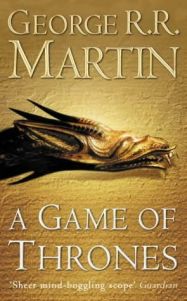
A Game of Thrones is the first novel in the fantasy series A Song of Ice and Fire by American author George R.R. Martin. A Game of Thrones was first published by Bantam Books and Voyager in 1996, however it was over a decade before it gained the readership it has today, following the very successful TV adaptation, Game of Thrones, in 2011. This in turn changed the initial target audience of the book from mature readers to young adults. The work of fiction focuses on four powerful families on the continent of Westeros, and their battle to win the coveted Iron Throne. Take away the swords/ occasional incest and each house would be like any other dysfunctional family; there’s sibling rivalry, family leaders and pets (albeit dragons and direwolves).
The novel begins in Winterfell where young Brandon Stark is about to witness the beheading of a deserter of the Night’s Watch. Martin’s choice to write such a morbid chapter from the point of view of an eleven year old is harrowing, but the American author starts as he means to go on. A Game of Thrones is an epic 780 pages of struggle, sex and scandal, yet it is a book that is almost impossible to put down. The tales of war reflect the teen angst of many of the protagonists’, coming of age in a time of conflict and tension where “when you play the game of thrones, you win or you die.” However, what makes the book a real treasure, in my opinion, is that it is not based around one age group, region or family; allowing for a richer reading experience and the chance to see the situation from various sides.
Each chapter focuses on the intertwining stories from a different character’s point of view. Even though the book is in third person, Martin manages to capture the essence and thought process of each character as if they were narrating the story themselves; from a rich dwarf to a young maiden married off as a pawn in her deluded brother’s selfish schemes. Although the characters may seem rather eccentric at first, readers begin to relate to them, this is largely due to their underdog status alongside Martin’s informal lexical choices. This also means that there is no black and white in terms of characters, each are their own unique shade of grey with their own endearing qualities and pitfalls.
A Game of Thrones is often associated with highly sexualised taboo subjects and violence. These are minor aspects to the book compared with the relationship building between the characters, and the unavoidable linking of their seemingly independent narratives. They are handled in such a manner that they do not seem shocking to the mature reader, rather they are realistic inevitabilities in a restless kingdom written by a brilliant author who does not view the world through rose tinted glasses.